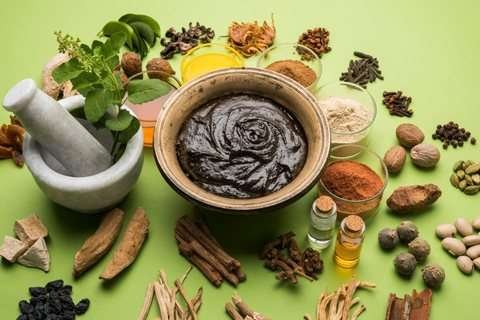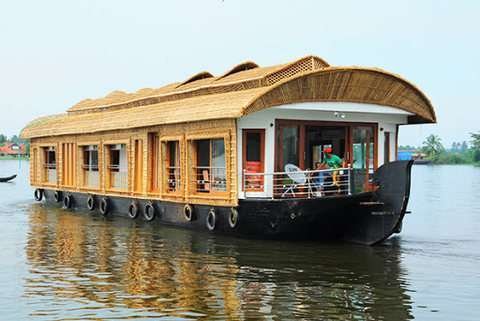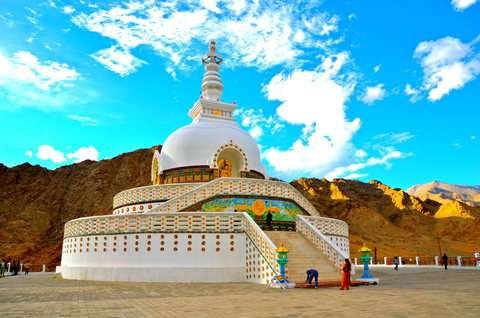Discover India




Discover India
India- is the Land of Temples, Mosques, Forts, The heritage Places & the great Himalaya peaks. India is truly a great country. It is the seventh largest country in the world and second in population. It is bordered by the Indian ocean on the South, Arabian sea in the South-West and the Bay of Bengal on the South-East. All four religions–Hinduism, Buddhism, Jainism, and Sikhism–originated in India. Many see India as a subcontinent, not a country. Different part of India there are different cultures, languages, customs. Official name-Republic of India. Indians call their country-India. There are also two other names for India less known outside India is BHARAT and HINDUSTAN.
New Delhi- is the capital of India. President: Mr. Ramnath Kovind, the Prime Minister Mr. Narendra Modi. India covers a total area of 3,287,263 km2 (1,269,219 sq m). India is the most populous country in the world. This is a Federal constitutional Republic, in accordance with a parliamentary system consisting of 29 States and 7 Union territories. The Holly River Ganga. India is a large country in South Asia with a variety of terrain – from the peaks of the Himalayas to the Indian ocean and has its own history of over 5000 Years Bc. To the North of the Mughal Empire . The sights of Delhi and the Red Fort. Complex in architecture and a massive mosque, the Jama Masjid in Agra is the Taj Mahal . Pilgrims bath in the Ganges in Varanasi and Rishikesh-center for yoga and a base for Himalayan trekking.
Cotton- was born in India for 4000 years BC. Traditional Indian dress varies in colour and style across regions and depends on various factors, including climate change and faith. Popular styles of dress include draped garments such as Sari for women and dhoti or lungi for men. Stitched clothes, such as shalwar kameez for women and Kurta–pajamas or European style trousers and shirts for men, are also popular.As well fine jewelry modeled from real flowers worn in Ancient India, is part of the tradition and has about 5000 years. Gem stones are also Born in India. India Has 4th Biggest Army in the Word & the great history of Indian soldiers. India have Tea Brand Assam tea, Kashmiri tea & the Great history of Indian Kerala spices.
Indian cuisine- includes a wide variety of regional and traditional cuisines native to India. Given the range of diversity in soil type, climate, culture, ethnicity and occupations, these cuisines differ substantially from each other.In Indian cuisine use many spices, herbs, vegetables and fruit. The Constitution of India recognizes 22 official languages. Besides Hindi, the following languages in descending order of the number wearing a lei, which everyone says is more than 25 million Indians – Bengali, Telugu, Marathi. We invite the world to see the beautiful India.
People of India- The overwhelming majority of India’s population shares essentially the same physical characteristics. There is no concrete scientific evidence of racial differences within this majority, although there are ethnic and cultural differences, such as language and religion.
Tribal Groups -There are also groups of people in India that have been identified by the government as tribal, meaning they belong to one of the more than 300 officially designated “scheduled tribes”. The tribal people are sometimes called hill tribes or adivasis (“original inhabitants”), and in 1991 made up about 8% (more than 65 million people) of India’s population. Members of India’s various hill tribes are thought to be indigenous and tend to be ethnically distinct. These groups typically marry within their community and often live in large, adjoining areas, which are preserved by government policies restricting the sale of land to tribe members.
Major tribes include the Gond and the Bhil. Each has millions of members and encompasses a number of sub tribes. Most other tribes are much smaller, with tens of thousands of members. Very few tribal communities now support themselves with traditional methods of hunting and gathering or with shifting cultivation because of government restrictions aimed at protecting the environment. Instead, they generally practice settled agriculture. Tribal groups tend to live in rural areas, mainly in hilly and less fertile regions of the country. Less than 5 percent practice traditional tribal religious beliefs and customs exclusively, most now combine traditional religions and customs with Hinduism or Christianity.
Most tribal groups live in a belt of communities that stretches from eastern Gujarât to western West Bengal. The western tribes speak a dialect of Hindi, the central tribes use a form of the Dravidian language, and the eastern tribes speak Austro-Asiatic languages. The other major concentration of tribal people is in the northeastern hills. Tribe members make up the majority of the population in the states of Mizoram, Nagaland, Meghalaya, and Arunâchal Pradesh. These people, many of them Christian, speak languages of the Sino-Tibetan family which are also spoken by the Buddhists who live along the Himalayan ridge, from Arunâchal Pradesh in the east, through Sikkim, northern Uttar Pradesh, and Ladakh (in Jammu and Kashmîr state). In the Himalaya particularly, isolation on the mountain flanks has led to languages so distinct that ethnic groups living within sight of each other may not understand each other. Other tribes live in southern India and on India’s island territories, but their numbers are not large.
Festivals of India Diwali- Diwali or Deepavali, the “festival of lights” is one of the most important of all Hindu festivals. It is believed that it was on this day that Lord Rama entered Ayodhya after fourteen years of exile. Deepavali is also celebrated as Naraka Chaturdashi, the day when the demon of darkness and dirt, Narakasura, was destroyed by Lord Krishna. The celebrations commence with a purifying oil bath and the lighting of lamps, symbolic of the spiritual light pervading the earth and the destruction of darkness and ignorance. It also celebrates the day Mother Goddess destroyed a demon called ‘Mahisha’ & Victory of Good over evil. The day is celebrated by lighting lamps, diyas, visiting relatives, feasting, and displaying fireworks.
Dusshera- Dusshera is usually celebrated in October. The mode and the fervor vary by a great deal across the subcontinent; the celebration in Mysore is one of the most famous. Different parts of India celebrate the festival in different ways. Some celebrate it as Navaratri, some as Vijaya-Dashami, and some as Dussehra, in worship of Goddess Durga or celebrating Rama’s victory over Rawana. The celebrations vary from a day to nine days (for Navaratri) to a month (for Mysore Dusshera).
Eid- Besides Hinduism, India is also the home of innumerable other faiths and the religious and cultural diversity of this nation is manifested in the large number of non-Hindu festivals. The sizeable Muslim communities have their Eids in common with Muslims across the world. Eidu’l Fitr, Eidu’l Zuha and Eid-e-Milad are the three festive occasions widely celebrated by Muslims in India.
Eid is celebrated with great enthusiasm all over the country, and one can see Muslims of all age groups and from all stratas of society attired in new clothes, visiting mosques to offer namaaz. The tombs of Sufi saints attract devotees of all religious persuasions, especially during the urs or death anniversaries. The best-known urs are centered at tombs in towns like Ajmer, Delhi, Manakpur, Nagore and Dongri.
Ganesh Chaturthi- Ganesh Chaturthi is celebrated as the birthday of Lord Ganesh. It is among the most celebrated of the festivals in India, and one of the few public celebrations (most involve families and friends and are celebrated privately). The festivities include fund-raising, building all kinds of innovative forms Ganesh idols, public performances of music and dance, cooking grand feasts and making a lot of noise. The festivities end when the idol of the year is immersed in water (visarjan), accompanied by loud shouts of Ganapati Bappa Moraya.
Raksha Bandhan- Brotherly duties and sisterly love are symbolized during the Rakshabandhan (ruk-shaa-bum-dha-na) festival in India. Women, old and young alike tie specially made threads and thread watches (rakhis) to their brothers to ensure their welfare, and protection from the evil.
Snake Boat Race- The most colorful water sport in Kerala is held on Punnamada Lake in Alappuzha on the second Saturday of every August. The Nehru Trophy was inaugurated in 1952 when the then Prime Minister Jawaharal Nehru visited the area and traveling from Kottayam to Alappuzha was escorted by the huge Snake boats. Snake Boats, Chundaanvallam, are the traditional battle vessels of Kerala. They are usually 60-65 meters in length and are named for their high sterns shaped like the hood of a snake. During races the stern is majestically caparisoned and decorated with a flag and brass ornaments. Silken parasols are arrayed along the entire length of the boat. There may be up to 95 oarsmen, 5 amarakkar (controllers) and 10 nilakkar (persons supposed to enhance the vigor and enthusiasm of the oarsmen). Other boat races are held throughout Kerala in July and August.
Yugadi – Hindu New Year Yugadi (a.k.a. Ugadi) is the first day of the Hindu calendar. In some parts of India, the tender leaves of neem mixed with jaggery are distributed on the occasion. The neem, extremely bitter in taste, and the sweet and delicious jaggery, signify the two conflicting aspects of human life – joy and sorrow. The combination is exchanged between friends to symbolize renewed warmth and love overcoming the difficulties of life. It is also an occasion to forgive old debts and forget old disputes.
Holi- The colorful festival of Holi is celebrated in most parts of India during February-March. The celebrations vary depending on region and local traditions, but the common part is exchange of colors. On the day of the Holi, people (men and women) irrespective of caste and creed mingle together and exchange colors. The celebrations can get wild and rowdy – it is one of the few occasions of the year that the sexes are allowed to mix freely. People use tools and tricks to spray, paint and drown friends and relatives in color
Pongal or Sankranti- This holy day marks the commencement of the Sun’s northern course in the Heavens, known as the Uttaraayana patha. Interestingly, this is the only festival in Hindu calendar that follows a solar calendar and is celebrated on the fourteenth of January every year (all other Hindu festivals are computed using the lunar calendar). Sankranti is termed as Pongal in Tamilnadu, and is celebrated with a popular dish with the same name. Kolams (Rangoli) and prayers constitute the celebration of the festival. People buy new clothes, ornaments, sugarcane and sweet candy for the festival. The farmers worship their harvested crops and share with friends and relatives. Women and young girls wear new clothes, gold and silver ornaments, offer flowers and visit their relatives and friends.
In different parts of India, the Sankranti is celebrated very differently. In the west the emphasis is on exchanging sugar coated seeds and nuts of different colors prepared by the housewives. In some other parts, exchange a mixture of teel, jaggery, fried gram, groundnuts (peanuts) which is called “Ellu Bella.
In the Mysore region, people decorate their houses and cattle. They also worship their crop and cattle. As part of the celebration they sing and dance, and look forward for flowering of the trees and singing of birds. In Hindu belief, a person dying on this auspicious day directly goes to the heaven. Bhishma, an elder in the epic of Mahabharata, is said to have waited for this day to breathe his last. It is also on this day every twelve years the Great Kumbh-Mela is held at Prayag.
Religion- Religion seeps into every facet of Indian life. Despite being a secular democracy, India is one of the few countries in which the social and religious structures that define the nation’s identity remain intact, and have continued to do so for at least 4000 years despite invasions, persecution, European colonialism and political upheaval. Change is inevitably taking place as modern technology reaches further and further into the fabric of society but essentially rural India remains much the same as it has for thousands of years. So resilient are its social and religious institutions that it has absorbed, ignored or thrown off all attempts to radically change or destroy them.
Hinduism- India’s major religion, Hinduism, is practiced by approximately 82% of the population. In terms of the number of adherents, it’s the largest religion in Asia and one of the world’s oldest extant faiths. Hinduism has a vast pantheon of gods, a number of holy books and postulates that everyone goes through a series of births or reincarnations that eventually lead to spiritual salvation. With each birth, you can move closer to or further from eventual enlightenment; the deciding factor is your karma. The Hindu religion has three basic practices. They are puja or worship, the cremation of the dead, and the rules and regulations of the caste system. Hinduism is not a proselytizing religion since you cannot be converted: you’re either born a Hindu or you’re not. Significant differences exist within this Hindu majority, arising not only out of divisions of caste, but also out of differing religious beliefs. One great divide is between devotees of the god Vishnu and devotees of the god Shiva. There are also Hindus who are members of reform movements that began in the 19th century. The most significant of these is perhaps the Arya Samaj, which rejects divisions of caste and idol worship. Hindus may come together also as devotees of a guru, such as Sai Baba. Despite its differences, the Hindu community shares many things in common.
Islam- There are more than 100 million Muslims in India (approximately 12% of the population), making it one of the largest Muslim nations on earth. Muslims are a more urban community than Hindus. There are many towns and cities in northern India where Muslims are one-third or more of the population. In addition to Jammu and Kashmir and the Lakshadweep islands, where more than two-thirds of the population is Muslim, major concentrations of Muslims live in Assam, West Bengal, Uttar Pradesh, and Kerala states. About one-quarter of all Muslims living in India live in the state of Uttar Pradesh. Muslim influence in India is particularly strong in the fields of architecture, art and food.
Buddhism- Buddhism was founded in northern India in about 500 BC, spread rapidly when emperor Ashoka embraced it but was gradually reabsorbed into Hinduism. Today Hindus regard the Buddha as another incarnation of the Hindu god Vishnu. There are now only 6.6 million Buddhists in India, but important Buddhist sites in northern India, such as Bodhgaya, Sarnath (near Varanasi) and Kushinagar (near Gorakhpur) remain important sites of pilgrimage.
Jain- The Jain religion also began life as an attempt to reform Brahmin cal Hinduism. It emerged at the same time as Buddhism, and for many of the same reasons. The Jains now number only about 4.5 million and are found predominantly in the west and southwest of India. The religion has never found adherents outside India. Jains believe that the universe is infinite and was not created by a deity. They also believe in reincarnation and eventual spiritual salvation by following the path of the Jain prophets.
Sikhs- The Sikhs in India number 18 million and are predominantly located in the Punjab. The religion was originally intended to bring together the best of Hinduism and Islam. Its basic tenets are similar to those of Hinduism with the important modification that the Sikhs are opposed to caste distinctions. The holiest shrine of the Sikh religion is the Golden Temple in Amritsar.
Other- Approximately 2% of the population is Christian and there are also a few small Jewish communities in ex-colonial enclaves. India’s population is rich with diverse ethnic and cultural groups. Ethnic groups are those based on a sense of common ancestry, while cultural groups can be either made up of people of different ethnic origins who share a common language, or of ethnic groups with some customs and beliefs in common, such as castes of a particular locality. The diverse ethnic and cultural origins of the people of India are shared by the other peoples of the Indian subcontinent, including the inhabitants of Pakistan, Bangladesh, Nepal, Bhutan, and Sri Lanka.
